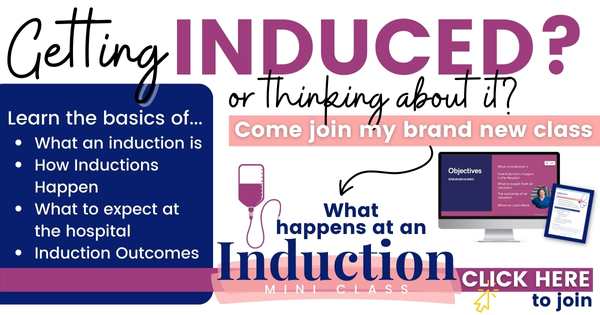Having a labor induction before or at 37 weeks is something each pregnant woman and her partner should consider carefully. This article will review WHY you might want/need to be induced, how it might happen, and why you might want to wait if possible.

As a reminder, I have literally helped thousands of patients be induced in person (and talked millions through it online). I’m an expert on this one, and I’m glad you’re here!
My BEST tip for inductions is to get your questions answered so you actually know what you’re facing (because SO many people do NOT). I have a question checklist right here:
Reasons Doctors Induce Labor At 37 Weeks:
I’m going to cliff notes this here, and then explain each one a bit more after that, along with what to expect at an early induction.
The top five reasons are:
- Preeclampisa or high blood pressure (they are different)
- Issues with the baby’s growth, most often IGUR or SGA (small for gestational age), but can be if baby is growing too large (LGA)
- Diabetes that isn’t being controlled well
- Too little fluid around the baby (called oligohydramnios), can also happen if there is too much amniotic fluid (polyhydramnios)
- Cholestasis (a blockage of your bile duct)
Let’s talk more about each of these, and why having a medical reason at 37 weeks is important!
Induction of Labor At (or Before) 37 Weeks
Medical Reasons for an Early Induction
Full term for a pregnancy is 40 weeks of pregnancy, so a 37 weeks (or before) induction is pretty early.
While 3 weeks might not SEEM like a long time, when you are trying to create an entire human inside your body, every day counts.
Also, something to keep in mind is that even early ultrasounds are not 100% accurate. Most predict your due date plus or minus 2 weeks. Which means at a point where you think you are 37 weeks, you could actually be 35 or 39 weeks (and anywhere in between). Which could be a big difference!
This early, you’d want to be sure to get informed consent before scheduling an induction. That means you understand the potential risks, benefits, and any alternatives of the procedure. That way you can make an informed decision.
This early, you would be induced mainly if your health or the health of your baby was severely impacted.
Before we get into this, it is REALLY important to understand why your provider wants to induce you — so many people come in having no idea why they’re being induced. Just ask questions, providers are used to questions, and we welcome them! Grab that questionnaire above to ask the right ones!
Ok, let’s dive a bit more into those reasons (and why they’re a reason to induce):
Baby is Too Small
This is also known as IUGR (intra-uterine growth restriction) or SGA (small for Gestational Age). At this point in time for this early of an induction, you would likely have had several ultrasounds that would chart that the baby isn’t growing well (or blood flow studies called doppler scans) that show baby isn’t getting enough blood flow.
They do often induce for big babies, but rarely would they do that at 37 weeks. I have a whole post on what to of your doctor says your baby is big.
Cholestasis of Pregnancy
This is where the bile duct is blocked. Women often have a rash/itchiness on belly and abdomen. Your health care provider would then order bile salts tested to see if that is the issue.
Because there is a high incidence of stillbirths, depending on the severity of you blockage, they can induce at 37 weeks, sometimes even before if it is bad.
FYI, once baby is delivered the rash/itching usually goes away.
Learn more about cholestasis here.
Too Little Amniotic Fluid in the Amniotic Sac
If they do an ultrasound (often what’s called a BPP — and I go into most of the 3rd trimester testing in this free course) they might find that you don’t have enough fluid.
This can be problematic as fluid gives the baby and umbilical cord more room in the womb.
There are ways to try to increase the fluids. We find many women are severely dehydrated (especially since I practice in Phoenix) and fluids can help you get closer to full term.
If your water breaks before 37 weeks it would be considered premature rupture of membranes (PROM), and they’d decide if they should induce contractions or wait to see if baby can grow more in a healthy environment. Keeping in mind that there is always an increased risk of infection once your water breaks.
Preeclampsia
Preeclampsia is a smooth muscle disorder that is diagnosed through lab work and blood pressures taken at rest. Most often is is characterized by high blood pressure found in the doctors office.
The only way to cure it is to deliver the baby and the placenta.
It can cause issues (including seizures) and can restrict the baby’s growth similar to IUGR if not taken care of. While they would probably prefer you got closer to 38 weeks, sometimes they will induce you at 37 weeks if it’s a serious condition.
Learn more about preeclampisa on my sister site.
Gestational hypertension would also be a reason for an early induction if it can not be controlled with medication. That is high blood pressure, without the other lab indictors that it is preeclampsia.
Diabetes
Diabetes is a very common reason for an early induction.
There are several types of diabetes. The most common one is gestational diabetes, which is tested for tested for by the glucose test.
Gestational Diabetes
This is diabetes that happens just during pregnancy. Some people are diagnosed early on or at around 30 weeks.
Most women, if controlled, can go past 37 weeks but if their sugars aren’t controlled they might need to be induced early.
Type 1 or Type 2 diabetic
These people have had diabetes before pregnancy and will continue to have it afterwards as well. Their body has more health-related concerns, and they will often be induced ahead of time.
Previous Stillborn
Having a previous stillborn baby can be a reason for an early delivery. While 37 week is pretty early, it can be the best option for maternal and fetal well being.
A history of a stillborn makes your entire pregnancy different. Doctors are aware you’ll be extra nervous.
Other Reasons
While these are some of the most common reasons, there are other reasons for an induction of labor including congenital anomalies they found on the ultrasound, twins, issues with the baby’s heart rate and other medical conditions.
Many people wonder why doctors push inductions << and that post goes into all the reasons why.
An elective induction (an induction without a medical indication) should not happen at 37 weeks. ACOG (American College of Obstetricians — their professional organization in the USA) recommends against it, it can put both mom and baby at an increased risk. I have a whole post on if you can request an induction at 37 weeks.
Remember the main reason they would induce you early is if staying in the womb would be bad for baby’s health. In fact, pain is not normally a reason for a 37 week induction.
Before we go any further, I will say that people facing an induction need a prenatal class (and a good one). I recommend this one — it only takes 3 hours and it’s SO easy and fun, couples love it!
Reasons for Inducing Labor at 38 Weeks?
They are most often very similar to the other reasons listed. in general, they will induce at 37 weeks if your condition is more severe, but at 38 weeks the chance of complications lessens, so they would induce you then if it wasn’t quite as severe.
At 39 weeks of pregnancy you can be induced electively (without medical indication). I have a whole chapter on The Arrive Trial on 39 Week Inductions in here you’ll find handy!
And at 42 weeks (or sometimes just past your due date) they will push induction again as your risk of stillbirth increases once you pass this point.
Being Induced at 37 Weeks: What to Expect:
37 week inductions are different than those at 39+ mostly because, most often, your cervix isn’t as ready — so, it often takes longer.
How they Induce You at 37 Weeks:
An induction of labor is meant to start uterine contractions. They can do that in a variety of ways (your particular induction process will depend on doctor’s preference and your initial cervical exam):
Manual Induction Methods
There are couple of manual induction methods (manual meaning something physical happens to your cervix):
Foley Bulb
As long a your cervix is open enough that they can get the tube in, they can insert a foley bulb.
That’s basically a tube with a balloon at the end. They fill the balloon with water and that manually opens the cervix with time.
Normally, it goes in for 12 hours. Some doctors will place it in the office, and some place it in the hospital.
It is mildly uncomfortable, but it isn’t too invasive.
Rupture Your Amniotic Fluid Bag
Your doctor can rupture your membranes (break your amniotic fluid sac) to see if that will get labor started. Most often, at 37 weeks this isn’t enough to get you going. Often, once you have had a cervical ripening agent (see below) they will break your water after that to hurry things along.
While many people include a membrane sweep in the manual induction methods, it is not usually chosen for an early induction because it isn’t very effective at putting you into labor and we need to choose something more likely to work (and more controlled).
Are you feeling overwhelmed by all of this yet? All of this can feel REALLY overwhelming!!! Which is why I REALLY recommend this when you’re going to have a few more choices that could have big consequences coming up!
Looking to get prepare for your birth? I have some easy options for you!
~~~~~~~~
– Worried you’re missing something? Grab my pregnancy planner so you don’t miss a thing!
– Thinking about an induction? Grab Inductions Made Easy to feel prepared in just 20 minutes!
– Wondering how to get that baby OUT? Grab Going Into Labor Made Easy so you know how to (and not to) do it!
– Postpartum got you anxious? Check out Postpartum Care Made Easy so you can stay SAFE even when all your attention is on that little on.
🚨 AND if ALL OF IT has got you on edge The Online Prenatal Class for Couples is perfect for you — You’ll feel so ready before you even know it!
~~~~~~~~
No matter WHERE you are at in your pregnancy journey, we have resources that can help!
Cervical Ripening Methods
This means that your cervix is less than 3 cm and needs to ripen (yes, like fruit) so that it will open up as we make you have harder/faster contractions.
All of these start with smaller contractions and don’t normally put you into labor on their own (but sometimes they do). The idea is to give these medications until your cervix is 3 centimeters and then we move to Pitocin (see below).
Misoprostil / Cytotec
This is a small pill that is given orally, placed by your gums/under your tongue to dissolve or vaginally. Learn more about Cytotec inductions here.
Prepidil
This is a gel we place in your vagina. It’s similar to a Monistat plunger I have used for a yeast infection before. This isn’t as common.
Cervidil
This is like a tiny flattened tampon (or a tiny stiff tea bag) that is placed in your vagina next to your cervix for 12 hours and then removed. Learn more about cervidil here.
IV Induction Method
Pitocin is the main induction method. It can also be given before the cervical ripening agents — it is up to your doctor.
Pitocin is the synthetic form of oxytocin, the hormone that makes your uterus contract.
It is given in the IV and is more high risk than the other method. Your blood pressure and fetal well being are more frequently assessed with Pitocin (and you will need to be monitored continuously).
All that being said, we use Pitocin frequently in labor and delivery, it isn’t unusual at all — and we are educated on how to use it safely. I have a whole article on Pitocin inductions.
A lot of these induction methods get a bad rap online — most often from people who don’t have a lot of experience with them. Be SURE to take your information from someone with LOTS of experience!
What happens at 37 week induction?
An early induction is usually a bit of an “uphill” battle as your cervix and mother nature are not normally on your side (this is totally different if you go into labor that early on your own). I have a whole post on what to expect at a 37 week induction you might find helpful too!
Bishop’s Score
This is a method of ranking how conducive to an induction your cervix is. It takes into account how many centimeters you are, how soft your cervix is and how effaced (or thin) it is. I go into all the info on vaginal exams in this post on my other site.
While a low bishop’s score wouldn’t stop us from inducing someone who really needed it done, it can tell you how long it might take, and that information is worth discussing with your doctor. A low bishop’s score before an induction would be a risk factor for a caesarean section instead of a vaginal delivery. It can also be a reason we’d choose Cytotec vs Pitocin.
How long will a 37 week induction take?
The textbook case once you are in labor is 1 centimeter per hour plus 2 hours of pushing on your first baby (much less on subsequent babies).
However, that only starts once you’re IN labor. That means your cervix is actively opening. That might take a while to get mother nature on your side with medication (and cervical softening by the agents we listed above).
Honestly, your induction may take a while — feel free to ask your provider how long they “guess” it will take. They DO have a guess in their minds (but are always hesitant to share it, because we never know). And even if they guess short, it may be long depending on how your body reacts to the medicine.
We have a whole bonus video on the stages of labor in here.
Risks of an early induction
The risk of an early induction is similar to the risks of induction at any stage. Once you add any intervention at any stage it does increase the risks.
Your induction is also likely to be lengthier than an average induction where someone is closer to 40 weeks gestation.
AND, there is always the chance it will fail and you will need a cesarean section. With an elective induction, there is always the chance that if you fail you can go home and wait a few days, possibly try again. If you NEED the baby out, they will need to do a cesarean section.
In general, they recommend inducing when the risks for baby and more are less than the risks of baby staying inside — they are weighing those too very carefully.
Inductions tend to want more pain management options — so learn more about them here:
Why Not to Get Induced at 37 Weeks?
Going full term is best for you and your baby, if your doctor recommends an induction early, be sure to understand why and if it could be pushed later (never a problem to ask questions). Your provider may recommend inducing labor, but they may also feel comfortable watching and seeing for another week.
In general, these problems don’t resolve themselves though. So you will likely need to consider an induction rather than waiting for labor to start.
Remember that “natural labor” (some people use that term to mean labor with less interventions) does put you at a lower risk for complications, and potential risks — so we try to aim for that when possible.
Remember that you think you are 37 weeks, but you could be just 35 weeks, and baby’s lungs might not be ready to breathe in the air (which is always a risk of an early induction).
If you and your provider decide that an induction of labor is not in your best interest, please don’t try “natural ways” like spicy food, castor oil, or nipple stimulation. There is a reason your baby is inside, and it would be best to not try and induce yourself (and I NEVER recommend castor oil, and I think spicy food just gives you heartburn).
However, if you go into spontaneous labor around 37 weeks, we most often have great outcomes.
Remember to KEEP doing those Kick Counts til’ you’re on the monitors, grab my cheat sheet here:
37 Week Induction FAQ’s
It REALLY varies on your cervix, and how well your body “takes” to the medication. Your provider will have a guess as to what to expect, so make sure you talk with them before going in (and bring some things to amuse yourself in case it takes a while — the hospital is very boring)
While everyone on the internet seems to say no, the Arrive trial (I have a bonus video about it in here) showed that those who had an induction didn’t rate their pain any worse than those who did not. As someone who’s had both I thin an induction is a whole lot more boring and there isn’t anything to distract you like there would be at home in early labor, which can feel more painful.
Yes! Remember, 40 weeks is the average — so most people are delivered about then, but many go early, and many go later than that date.
Be sick, and not healthy enough to continue pregnancy or to provide your baby the womb they need to grow and thrive. That really is the only way. Hospitals do not allow an elective induction (an induction for no medical reason) prior to 39 weeks.
Not in the hospital methods are guaranteed to work. If baby truly needs to come out, they may have to do a cesarean as often bodies will fight going into labor so that baby can stay inside longer.
A 37 week induction often comes with an increased risk of a possible cesarean, but that can be due to the issues surrounding mom or baby that is requiring the induction. Most often, 37 week inductions happen just fine, and I’d encourage you to stay positive about it. BUT, be sure to talk with your doctor about the risks, benefits and alternatives to your induction.
You can always ask, but if there isn’t a medical reason, the provider will not be able to schedule you.
Ok, that was a whole LOT of info. I am glad you made it all the way here. It is a LOT. Especially if you have concerns if you’re making the right choices or what will happen.
Can I tell you how much better it feels to be prepared, not scared? I hope that this article has helped a bit with that, but… there’s a whole lot more to labor. The Online Prenatal Class for Couples is your best bet in labor prep (and you can do it from HOME).
In that class you’ll:
- Learn how to talk with your provider to get the most information to make the best choices for yourself
- What the whole induction process will look like (a whole chapter just on inductions from an expert)
- Keep your expectations for labor correct (so you’re not begging for a c-section to just end it).
And, if you’re not quite sure you want a whole class, check out my quick induction class that takes just about 30-minutes and prepares you in depth for what to expect at your induction (and how to make the right choices for yourself).










 Pain Between Your Legs During Pregnancy: Is it Pelvic Pain?
Pain Between Your Legs During Pregnancy: Is it Pelvic Pain?

[…] Often medically necessary inductions happen before you are due. I have a whole post on 37 week inductions. […]